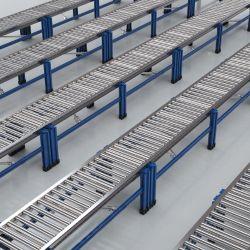Conveyor systems are crucial components in modern industrial processes, facilitating the efficient movement of materials and products throughout manufacturing and distribution facilities. To ensure the smooth functioning of conveyor belts, proper jointing techniques are essential. Conveyor jointing refers to the process of connecting conveyor belts into a continuous loop to form an uninterrupted transportation path. In this comprehensive discussion, we will explore the different methods of conveyor jointing, their advantages, disadvantages, and their impact on the efficiency and reliability of conveyor systems.
- Mechanical Fasteners:
Mechanical fasteners are one of the most common methods of conveyor jointing. They involve using metal fasteners to splice conveyor belts together. The process is relatively simple, cost-effective, and quick, making it a preferred choice for temporary or lightweight applications. The joints formed by mechanical fasteners create a smooth transition that allows the conveyor to run smoothly and reliably. However, they may not be suitable for heavy-duty applications or conveyors handling sharp-edged materials, as the fasteners can wear out quickly.
- Vulcanization:
Vulcanization is a method of conveyor jointing that uses heat and pressure to chemically bond two conveyor belt ends. This process creates a seamless joint that is durable and capable of withstanding heavy loads and abrasive materials. Vulcanized joints offer excellent tensile strength, reducing the risk of belt separation and downtime. The reliability and longevity of vulcanized joints make them suitable for high-temperature applications and conveyors operating in harsh environments. However, the vulcanization process can be time-consuming and requires skilled labor and specialized equipment.
- Cold Bonding:
Cold bonding is an alternative to vulcanization, where adhesive compounds are used to join conveyor belts. This method is more straightforward than vulcanization and does not require high-temperature equipment. Cold bonding is best suited for lightweight and medium-duty conveyor belts. The joints formed by cold bonding are generally flexible, allowing the belt to navigate small-diameter pulleys smoothly. However, cold-bonded joints may not be as durable as vulcanized joints, and they may require more frequent maintenance and replacement.
- Metallic Lacing:
Metallic lacing, also known as wire hook lacing, involves interlocking individual wire hooks to join the conveyor belt ends. This method is often used for belts with a thin cross-section or in applications where the belt needs to be installed or replaced frequently. Metallic lacing offers a strong joint that can withstand moderate loads. However, it may not be suitable for heavy-duty or high-tension applications, as the lacing can deform or damage the belt over time.
- Plastic Spiral Lacing:
Plastic spiral lacing is a relatively new method of conveyor jointing that utilizes plastic spiral-shaped connectors to join belt ends. The connectors are inserted through the edges of the belt, creating a flexible and strong joint. This method is easy to install and requires no special tools, making it a convenient option for temporary or lightweight conveyor systems. However, plastic spiral lacing may not be as durable as other methods, and it may not be suitable for high-tension applications.
